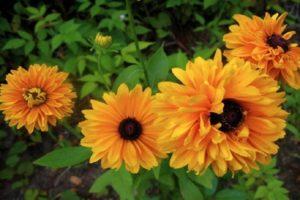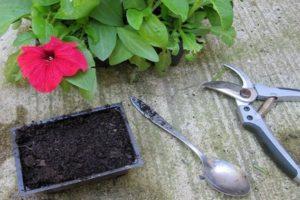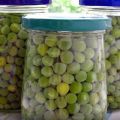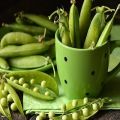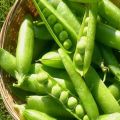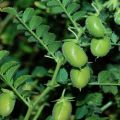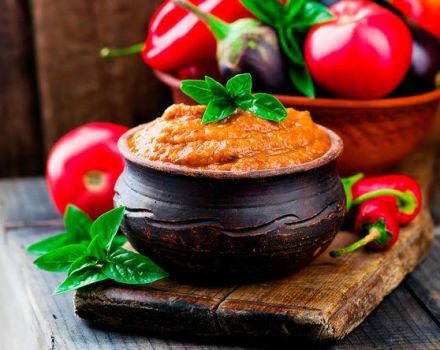Description of 30 varieties and types of sweet peas, planting and growing from seeds
Pea or fragrant rank is a cultivated species of an ornamental perennial herb. It is grown for landscaping the site, as an ornamental culture. China has many varieties and types. Many of them grow wild and are found in their natural environment. Breeders have bred more than 1000 varieties of peas.
Description and features
Sweet peas belong to the Legume family, a genus of rank. Its feature is the symbiosis of the root system with beneficial bacteria that enrich the plant with nitrogen. This is a perennial crop, however, in the middle lane it is grown as an annual.
The creeping plant, clinging to the support, forms dense stems, reaching 1.5 - 2 meters in length. The leaves are elongated, lanceolate. The antennae are located on the stem, with which Chyna clings to the support. Flowers of different colors depending on the species and variety. They consist of large petals, the inflorescences resemble a moth. Each cluster has 5 - 12 flowers.
Flower shoots are formed after the formation of 9 internodes, in later varieties after 12 internodes. Flowering begins in late June and ends in September. After flowering, seeds are formed in the form of beans.
Important! The fruits of sweet peas are poisonous, their use for food is prohibited.
Kinds
China has wild and cultivated species. Many of them can be found in their natural environment in the forest, field, on the edges.
Peas or fragrant rank
Plant height from 2 to 2.5 meters, peduncles from 12 to 18 centimeters. The flowers are light pink, almost white. It has been studied by botanists since the 17th century. In inflorescences 4 - 9 flowers are collected. The foliage is light green, paired, ends with antennae. Peas bloom in July and continue to bloom until the end of August. The seeds are golden brown.
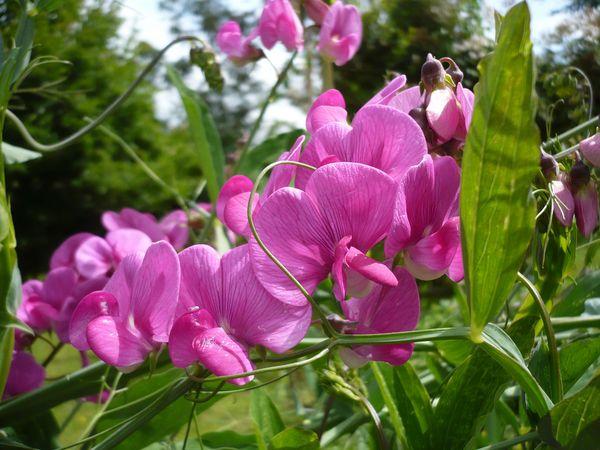
Fragrant
An annual climbing plant. Grown as an ornamental plant. It reaches a height of almost 2 meters. Flowering begins in July and lasts 2 months. It takes root well in the middle lane, gives lush inflorescences of various colors.
Forest
A perennial herb, reaching a height of 2.5 meters. The leaves are lanceolate, the flowers are bright pink or purple.A branched culture, clings to neighboring plants, grows on the edges, clearings, next to shrubs.
Spring co-worker
The plant is not tall, the leaves are single-pinnate, lanceolate, elongated. Widespread in deciduous forests. Flowering occurs in late May or early June. Forms bright purple or pink inflorescences. After flowering, the petals do not fall, but remain for the formation of seeds.
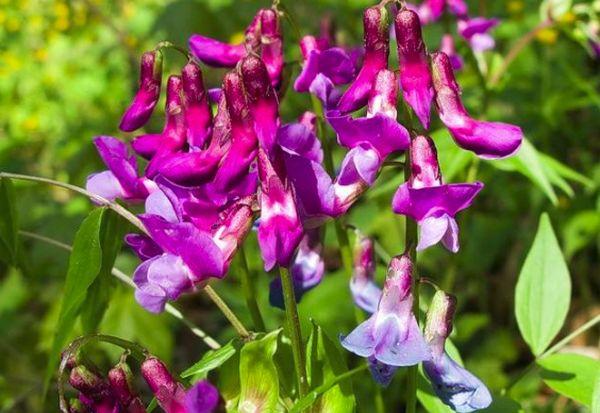
Tuberous
Perennial, herbaceous plant. The leaves are wide. Lanceolate with antennae. The culture blooms in June and until the end of August. The stem is branching, the flowers are bright red, with a characteristic pleasant smell. China is a weed that is common in cereal fields.
Gmelin
The species reaches a height of up to 1.5 meters. The flowers are collected in inflorescences, at the beginning of flowering their color is light yellow, towards the end they become orange. Peas bloom for 2 months, starting at the end of June, then forms brown fruits. Leaves are green lanceolate.
Popular varieties
Breeders all over the world were engaged in the development of new varieties of ranks. Many of them were bred in the last century and are still popular today.
Duplex
The culture has strong stems, forms flowers with a double sails, collected in inflorescences of 5-6 pieces. It blooms from mid-summer to August. Forms brown fruits. It is an annual.
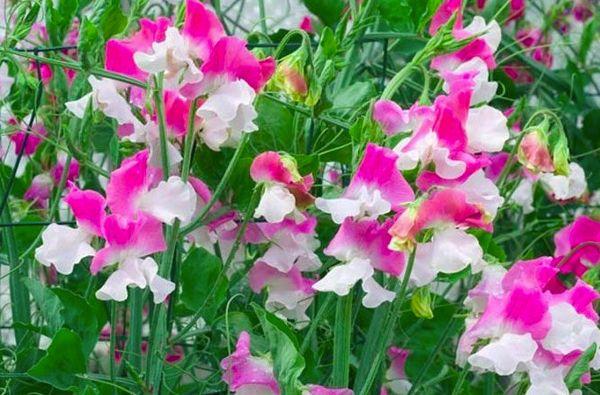
Cream
China reaches a height of 100 cm, flowering begins at the end of June. Light beige flowers are formed, collected in inflorescences of 4 - 5 pieces. The diameter of the flower is 5 cm. Peduncles are large up to 20 cm. The leaves are bright green, with tendrils.
Galaxy
The variety was bred in the 60s of the 20th century. Peas reach a height of 2 meters, forming dense inflorescences of 5-9 flowers. Flowers are double, their edges are wavy. Peduncles are up to 50 cm long. Leaves with antennae of bright green color. The flowers are blue, purple or beige.
Neptune
Creeping variety, with long peduncles up to 30 cm, lush inflorescences of 5 - 7 bright blue flowers with a white base. The plant reaches a height of 1.5 meters. They are planted next to fences and fences.

Milky Way
A branchy plant with a dense stem, up to 1.5 meters in length. Flowering begins in late June. Forms lush inflorescences of 4 - 5 light beige flowers. Strong flower stalks about 20 cm. Leaves with tendrils.
Bijou
Bijoux was bred by American breeders in the 60s of the 20th century. This dwarf crop is suitable for planting along curbs and alleys. The stems are dense, reaching a height of 45 cm, the inflorescences are collected in bunches of 4 - 5 colors of bright purple or burgundy. Terry flowers with wavy edges.
Spencer
Plants of medium maturity with dense stems, up to 2 meters high. Inflorescences form brushes of 4 - 5 flowers. Recommended for cultivation for landscaping purposes. The flowers are large, up to 5 cm in diameter, molding green with antennae, lanceolate. Flowers are purple, pink, crimson, beige.
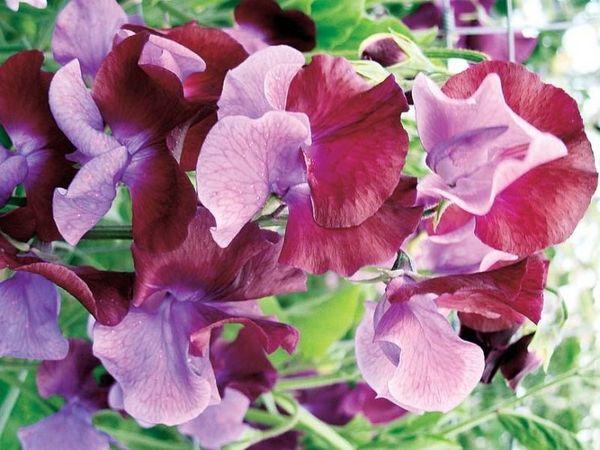
Warriay
Multi-stem culture up to 2 meters high. Flowers are bright purple in color, collected in inflorescences of 4 - 5 pieces. Peduncles are straight, 20 cm long. Flower diameter is about 40 mm. The leaves are elongated green.
Jumbo
The height of the stem is about 1 meter, the flowers are pink-orange, bright, collected in rosettes of 4-6 pieces. Polka dots have a characteristic pleasant smell, flowers are about 4 cm in diameter. Peduncles are straight, up to 20 cm long.
Charlotte
The stems are dense, with green leaves, attached with tendrils. It reaches a height of 1.5 meters. Inflorescences are bright pink, crimson, about 4.5 cm in diameter. Flowers are collected in rosettes of 2 - 4 pieces. Straight peduncles 25 cm long.
Cream Gigantic
Climbing culture, with a dense stem 1.8 meters long. Forms inflorescences of 4 - 5 flowers of white, milky color. Peduncles are straight, 30 cm long.The leaves are green, elongated with pointed ends.
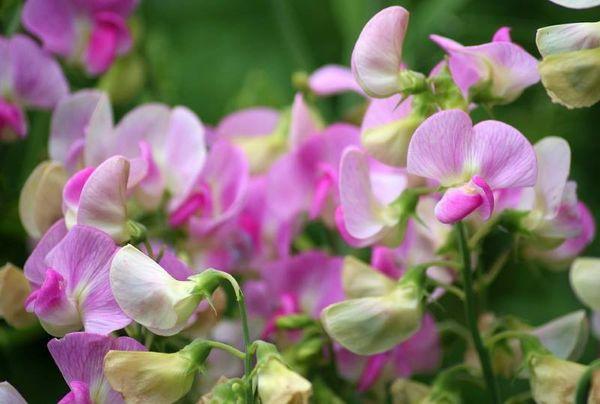
Cuthberson - Floribunda
China was developed by American breeders in the 50s of the 20th century. The stems are undersized, up to 30 cm long, with peduncles up to 7 cm, consisting of 2 - 3 flowers. Used to decorate garden beds and low fences. The color is red, bright pink or white.
David
The stem height is 1.5 meters. Green leaves with tendrils, lanceolate, form on it. Inflorescences consist of 5 - 6 flowers, 5 cm in diameter. Their color is bright purple with small white spots. Peduncles 30 cm long.
Kenneth
Stems are dense, up to 1 meter high. Forms lush inflorescences of 5-6 crimson flowers, with small white spots. The flower is 4 cm in diameter and has wavy edges. Peduncles are straight, about 16 cm.
White Pearl
A tall climbing plant with stems reaching 1.8 meters. Peduncles are 30 cm long, inflorescences are large, consist of 5 - 7 white flowers. The flower diameter is 45 mm.

Grace
Leaves are green, elongated with tendrils. The stems grow up to 1.5 meters, cling to the support. Flowers bloom in early June. They have a delicate lilac color with bright purple stripes. Collected in inflorescences of 5 - 6 pieces. Dense peduncles in length reach 35 cm.
Ramona
Climbing culture up to 1.3 meters long. Flowers with a diameter of 50 mm, collected in lush inflorescences of 5 - 7 pieces. The color is bright pink - red. The peduncle is dense, 30 cm long.
Lucien
Low-growing rank grade. Stem length 50 - 60 cm. Flowers located at the top are light pink in color. Inflorescences consist of 8 - 12 flowers, with wavy edges.
Lisette
A low-growing culture, about 40 - 60 cm high, the flowers are bright red, with a very pleasant fragrant aroma. Leaves are green, elongated, paired.
Growing seedlings from seeds
To grow seedlings from seeds, it is necessary to prepare them, select the soil and plant them correctly.
Seed preparation
Before planting, the seeds are soaked in hot water for 10 hours. Then they are lowered sawdust and kept for 3 - 4 days at a temperature of 18 - 20 ° C. After the seeds have germinated, they are lowered into the soil. This procedure is carried out in early March.
Important! In the southern regions, seeds are planted in open ground without soaking.
Selection and preparation of soil
Peas prefer moistened peat soil. It can be purchased ready-made at flower shops. You can also compose it yourself. To do this, take:
- peat 2 parts;
- humus 2 parts;
- turf soil 2 parts;
- sand 1 part.
How to plant
When growing seedlings, the mixture is placed in plastic pots. The soil is watered with warm water, give time to absorb. They make a small depression about 2 cm. Place the seeds there, cover with earth. Seeds sprout after harvesting only for the first 2 - 5 years.

Topping
After the formation of 2 - 3 strong leaves, they are pinched to form side shoots. After pinching, the plants are fertilized.
Watering
It is necessary to water the culture regularly, the rank loves moist soil. During the flowering period, watering is carried out every week. For a square meter of culture, 35 liters of water are spent at a time. Water is distributed near the roots, trying not to hurt the leaves.
Top dressing
During the growing season, feeding is carried out three times. The first is at the beginning of the pea growth, the second is at the beginning of flowering, and the third is at the height of flowering.
The first
Carried out after the emergence of sprouts and pinching. Nitrogen fertilizer and urea are added to the soil.
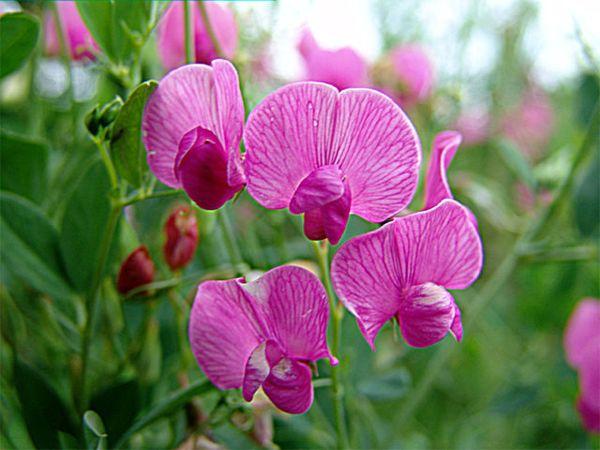
The second
At the time of bud ovary and blooming of the first flowers, 1 tbsp is applied. l Agricola and potassium sulfate. The mixture is diluted with 10 liters of water and the plant is watered.
Third
In the midst of flowering, peas need a lot of minerals. 1 tbsp is applied to the soil. l Agricola and Ross. The dry mixture is diluted with 10 liters of water and poured over the rank.
Garter
Tall curly varieties are planted next to fences, racks or other supports. When the peas grow, they are tied to a support so as not to damage the plant in strong winds and rains.
Pruning
During the flowering period, the plant does not need special pruning. Old inflorescences are periodically removed. This contributes to the formation of new peduncles. At the end of the season, the perennial rank is cut to the ground and covered for the winter.

Transfer
With unsuitable soil, peas do not grow well and give inflorescences uncharacteristic for the variety. In addition to the soil, there may be insufficient lighting and constant draft. In this case, it is recommended to change the growing location. To do this, the bush is dug up, the soil and the roots are captured. The plant is transferred to a new site prepared in advance. The rank is planted, after clearing the roots from the past soil. The stem is spud at the base for the accelerated formation of new roots.
Diseases and pests
Sweet peas are susceptible to infection and attack by harmful insects. When the first signs appear, it is necessary to treat with special drugs.
Aphid
Small insects that feed on chin leaves. They are localized on the underside of the leaf, forming a black bloom. Insecticides are used to combat them.
Nodule weevil
Insects feed on roots, leaves and legumes. They lay the larvae in the soil, which infect the roots. To combat them, they carry out regular hilling of the crop and use insecticides.
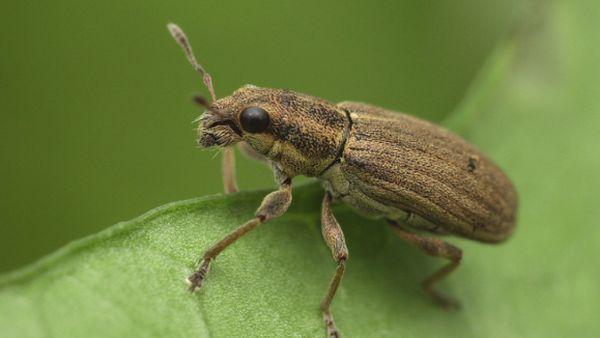
Ascochitosis
It affects the upper leaves of the plant, shoots and fruits. Yellow spots are formed on them, with a black halo. Fungus causes disease. When the stage is advanced, it infects the seeds of the rank. To combat it, fungicides are used.
Powdery mildew
The infection manifests itself with increased moisture. The immunity of the culture decreases and powdery mildew develops. It infects the leaves, forms a white bloom on them, spreads quickly. To combat it, the damaged shoots are removed, and the bush is sprayed with a fungicide or copper sulfate.
Peronosporosis
Outwardly, the disease looks like powdery mildew. Light yellow spots are formed on leaves, shoots, buds and flowers. The plant is affected by frequent rains and low temperatures. To eliminate the problem, spraying with copper sulfate is carried out.
Fusarium
Microscopic fungus that infects the leaves of the plant. It develops with frequent rains and adverse weather conditions. The disease begins with the lower leaves, black spots form on them. The leaf blades gradually turn yellow and dry. When signs appear, they are treated with a fungicide.
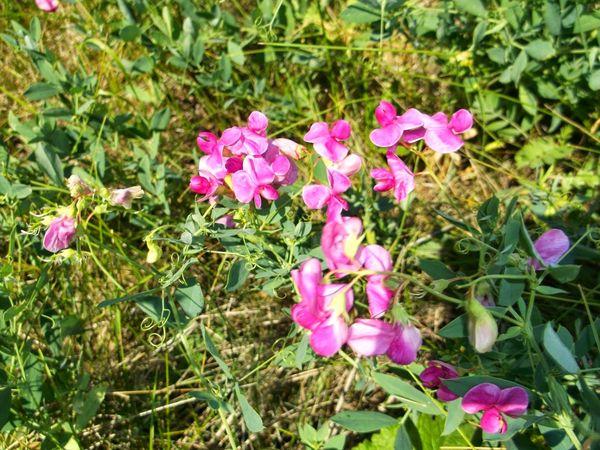
Root rot
With increased watering and frequent rains, root rot is observed. The root system of the plant rots, the roots become soft and fall off from the base. The plant does not receive the necessary nutrition and begins to die slowly. To prevent development, drainage is formed before planting.
Blackleg
A gray bloom forms on the root portion of the stem. The stem becomes soft, turns black. The fungus begins to infect the roots of the rank, the plant dies. It is almost impossible to save the plant. When signs appear, it is removed from the site and destroyed.
Viral mosaic
Important! To prevent contamination of the culture, treatment with fungicides and insecticides is carried out at the beginning of the growing season.
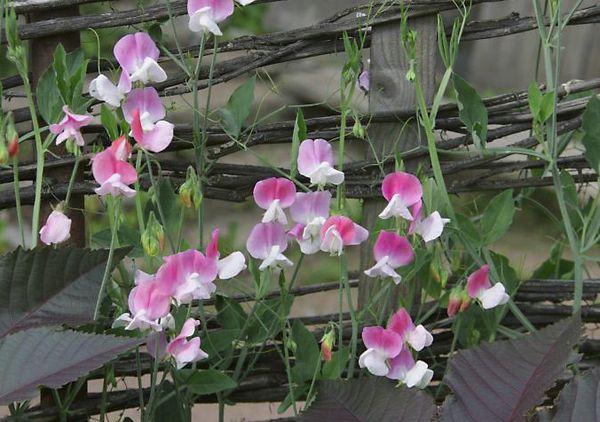
Preparing for winter
Annual pea varieties are dug up and destroyed. Perennial varieties, after pruning, cover for the winter. To do this, use straw, sawdust or special breathable fabrics.
Secrets
Secrets of Successfully Growing Sweet Peas:
- When planting seedlings or seeds, it is necessary to lay a drainage to drain excess liquid.
- At the beginning of the growing season, prophylactic treatment against infections and pests is carried out.
- Chyna prefers areas with good lighting.
- With frequent rains, watering the peas is reduced.
- Perennial plants are covered for the winter.
- The seeds of the ranks are used only for the first 2 - 5 years.
